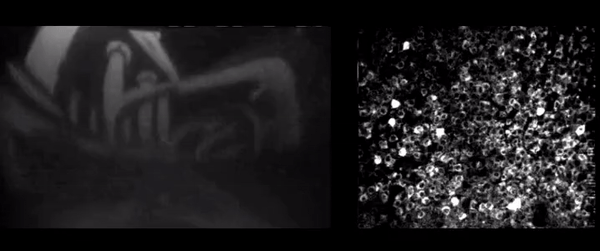By following neurons in the hippocampus over months, researchers have developed a model that shows how “place cells” respond to different scenery.

Inside a darkened lab, a mouse is running through a virtual maze. Every few days for the past three months, it’s paid a visit to this space. Running in place atop a ball, it’s gradually learned to navigate the computer-generated landscape. And scientists have been keeping tabs on its brain the whole time.
By tracking the behavior of a set of neurons in the mouse’s hippocampus as the animal explores, scientists are honing their understanding of how this brain region builds mental maps of the world.
“We’ve built a unified model of how the hippocampus represents space under different conditions,” says Albert Lee, a Janelia Research Campus group leader who co-led the work with Group Leader Sandro Romani.
The model, developed by Janelia postdoc John Briguglio, rests on one key property of these neurons – a measure of how likely they are to fire in response to particular locations and features in a landscape. This property differs between cells but remains consistent over time within each cell, even when the landscape shifts, the team reports October 8 in the journal Cell. That might help explain how the hippocampus can encode and retrieve detailed maps of the many environments an animal encounters over its lifetime.
The neurons Lee and Romani’s team studied are known as place cells – cells that fire when an animal is in a particular spot in the environment. Different place cells respond at different locations and to different sets of cues, such as landmarks and rewards. Collectively, place cells create mental maps that help animals position themselves relative to the world around them.
To better understand how place cells encode these mental maps over time, research scientists Jae Sung Lee and Jeremy Cohen developed virtual landscapes for mice to explore. Mice navigated each habitat by running in place on a ball, while projected videos created the illusion of movement. Jae Sung Lee followed place cells in each mouse’s hippocampus over a period of months, recording from the same set of cells every time mice visited the virtual arena. Researchers switched mice between landscapes periodically, in order to understand how the mice’s brains responded to changing features.
Then, for each place cell, the team analyzed a metric they called propensity – essentially, how likely each cell was to fire over this three-month period. Place cells with a lower propensity seem to be triggered by very specific locations, and so fire less often. Place cells with high propensity seem to respond to a broader range of locations, so they tend to fire more frequently.
Surprisingly, a place cell’s propensity is stable across time and across different environments, the team found. It’s a quality of the cell itself. “Each cell has its own propensity, and that propensity lasts,” Lee says.
Over the weeks, the specific locations that triggered a place cell to fire shifted a bit, the researchers found. Cells no longer responded exactly as they did when the mouse was originally in a spot. And when the landscape switched, the same place cell might respond to totally different stimuli. But no matter the scenery, the cell still had the same propensity.
That’s interesting, Lee says, because it suggests that what’s consistent about place cells over time isn’t the specific cues they respond to, but their likelihood of signaling. A high propensity cell might get the same inputs from other neurons as a low propensity one, but it would amplify them more, and thus more often cross the threshold for firing.
“We’ve shown that you flip different coins for different neurons, and these coins are not fair coins – the probability that you come up with heads or tails changes across neurons,” says Romani.
Variation in propensity might help brains map the world more effectively, the researchers suggest. Cells that are low propensity don’t fire very often, so they can give a lot of information when they do fire – like a special ringtone that only goes off when your mom calls. High propensity cells fire frequently, so each instance doesn’t give as much information. But by being less specific, they might free up resources to help the brain handle a wide range of environments. (Having a unique ringtone for every person who calls you might quickly become overwhelming and inefficient.) That balance gives the hippocampus both specificity and flexibility.
It’s too soon to say exactly why propensity varies between cells, or what leads different cells to establish different propensities, Romani says. “It's a completely new dimension that one needs to understand and play with, and it opens up this broad spectrum of things to test.”
###
Citation
Jae Sung Lee, John Briguglio, Jeremy D. Cohen, Sandro Romani, and Albert K. Lee. “The statistical structure of the hippocampal code for space as a function of time, context, and value.” Cell, Published online October 8, 2020. Doi: 10.1016/j.cell.2020.09.024





